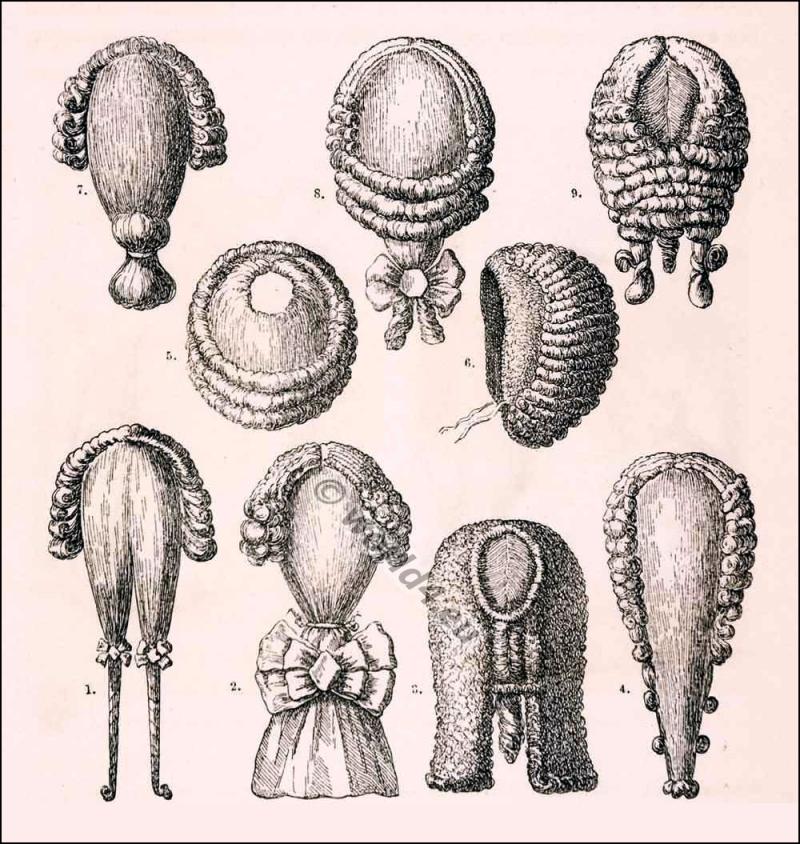
FASHIONS OF THE DAY: BEARD, HAIR AND WIGS. HISTORICAL FIGURES. CLERGYMEN, STATESMEN AND WARRIORS.
GERMANY. XVII, XVIII, CENTURY.
Number 1, 14 and 15.
Clergymen.
Nos. 2, 3, 4, 6, 7, 8, 9, 11, 13, 16 and 17.
Lawyers, clerks, teachers.
Numbers five, 10 and 12.
Warriors.
In the 16th century people started to wear beards again. In France this fashion was initially limited to the laity, in Italy the Catholic clergy and in Germany the Protestant clergy set the example. Under Louis XIII, the beard began to disappear and finally evaporated into the royal, a small fly on the chin. The whiskers and chin beard had gradually diminished to such an extent that this complete disappearance was hardly noticed.
The successor of Henry IV brought about a new change by wearing long hair, and since not everyone enjoyed luxuriant hair growth, they resorted to artificial means. They started with the postiche, a false strand of hair, and around 1629 the first wigs appeared. Civil servants, professors and lawyers mainly wore the wig à calotte, which had probably been introduced by Richelieu.
The characteristic hairstyle of the time of Louis XIV is the colossal in-folio wig, while in the last years of the XVII century only the powder wig was known.
In the first years of the XVIII. In the first years of the XVIII century only princes and lords in large ceremonial costume, officials and lawyers in official costume wore the wig.
The different changes in beard and hairstyle were the same throughout Europe.
The examples shown on our table are exclusively of German origin.
CLERGY.
No. 14. Lucas Gernlerus, Professor of Theology and Church History at the University of Basel. Hair curled under a cap; upwardly turned whisker and long chin beard.
No. 15. Egidius Strauch from Wittenberg. Doctor of theology, pastor and rector of the grammar school in Gdansk. Portrait from 1682.
Perrücke à calotte hairdo. Moustache turned upwards, long split chin beard.
No. 1 Andreas Mühldorf, preacher of Sanct Sebald in Nuremberg, professor of theology and church history. Born 1636. Wig as it was worn before the en crinière de lion. Completely shaved.
LAWYERS, CIVIL SERVANTS, PROFESSORS.
No. 6. Conrad Peutinger, city clerk of Augsburg. Born 1465, died 1547. Plain hair, combed over the forehead. Sharp mustache. Long chin beard.
No. 7. Jeremias Dumlez; portrait from 1687. Long hair combed up over the forehead. Mustache à la coquille. Sharp chin beard.
No. 3. Hieronymus Petrus Stetten, magistrate of the free city of Frankfurt; born 1609. Portrait of 1669. Long hair curled at the sides. Thin moustache, small bow tie.
No. 11 Leonhard Weiss, Council of Emperor Ferdinand III, Member of the Augsburg Municipal Council. On the parting short shorn hair, puffed at the sides. Mustache and bow tie.
Number 8. Zachariah Stenglinus. Councillor of the Duke of Württemberg and Syndicus of the free city of Frankfurt; born 1604. died 1674. Long wig – falling over the shoulders in front and behind. Thin strip of beard on the upper lip.
Number 13. Unidentified person. Wig à calotte; thin moustache turned upwards. Costume from about 1670.
No. 2 Kaspar Ziegler, Professor of Law, Council of the Elector of Saxony. Wig en crenière de lion. Thin mustache and bow tie.
No. 9. Johann Jakob von Berg. Member of the magistrate in Regensburg. In-folio wig (allonge wigs were called grand in-folio). Completely shaved.
No. 4. Johann Christoph Thill, councillor in Regensburg; born 1659. died 1728. long powder wig from the beginning of the 18th century. Official attire.
No. 16. Johann Christoph Wildius. Member of the magistrate in Regensburg; 1670-1743. Powder wig as it was usual for the official costume.
WARRIOR.
Number 12. Conrad Widerholtius. General in the Thirty Years’ War. Long falling hair; moustache à la coquille and royale on the chin.
No. 5. military type; unknown person. Moustache en croc with the royal; long hair.
No. 10. Friedrich, Margrave of Baden and Hochberg; born 1594 died 1659. curly wig; small moustache and bow tie.
Illustrations after simultaneous engravings by the Kilian brothers, by Somer, Böner, Heiss etc. after Matthäus Merian, Crams and Kirchmair.
Cf. J. B. Thiers, Histoire des perruques, Paris, 1690 – Memoires pour servir à l’histoire de la barbe de l’homme, Liège, 1774.
Source: History of the costume in chronological development by Auguste Racinet. Edited by Adolf Rosenberg. Berlin 1888.
Related
Discover more from World4 Costume Culture History
Subscribe to get the latest posts sent to your email.






